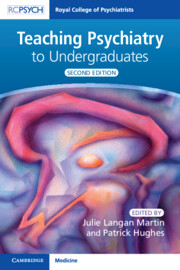Book contents
- Teaching Psychiatry to Undergraduates
- Teaching Psychiatry to Undergraduates
- Copyright page
- Contents
- Contributors
- Section 1 Principles of Medical Education
- Section 2 The Undergraduate Psychiatry Curriculum: Planning and Delivery
- Section 3 Clinical Placements in Psychiatry
- Section 4 Formal Teaching
- Section 5 Materials Development
- Chapter 5.1 Online Learning
- Chapter 5.2 The Flipped Classroom
- Chapter 5.3 Use of Technology and Social Media
- Section 6 Gathering feedback and quality improvement
- Section 7 Student Welfare
- Section 8 Developing as a medical educator
- Index
- References
Chapter 5.1 - Online Learning
from Section 5 - Materials Development
Published online by Cambridge University Press: 12 October 2022
- Teaching Psychiatry to Undergraduates
- Teaching Psychiatry to Undergraduates
- Copyright page
- Contents
- Contributors
- Section 1 Principles of Medical Education
- Section 2 The Undergraduate Psychiatry Curriculum: Planning and Delivery
- Section 3 Clinical Placements in Psychiatry
- Section 4 Formal Teaching
- Section 5 Materials Development
- Chapter 5.1 Online Learning
- Chapter 5.2 The Flipped Classroom
- Chapter 5.3 Use of Technology and Social Media
- Section 6 Gathering feedback and quality improvement
- Section 7 Student Welfare
- Section 8 Developing as a medical educator
- Index
- References
Summary
The development of the internet and growth in technologies has led to the surgency of online learning, including in the field of psychiatry teaching. Online learning provides student with greater flexibility in their learning, particularly for those engaged in postgraduate training, Effective online leaning provision requires planning, time, resources and support. Various approaches can be taken to deliver psychiatry teaching, such as the use of pre-recorded videos of content provision and virtual patient simulations. However, a key element of online learning is communication and collaboration both within the cohort and with the teacher. Teacher presence and input is vital to ensure a quality learning experience. Discussions of cases can also be successfully supported online along with branched decision-making. Communication skills can also be developed online and then augmented with face to face sessions. Blended learning has been successfully implemented in psychiatry teaching, particularly in terms of the flipped classroom approach. Online, blended and hybrid learning are areas of education that have grown in recent years and these approaches can be beneficial in psychiatry teaching.
- Type
- Chapter
- Information
- Teaching Psychiatry to Undergraduates , pp. 122 - 129Publisher: Cambridge University PressPrint publication year: 2022

